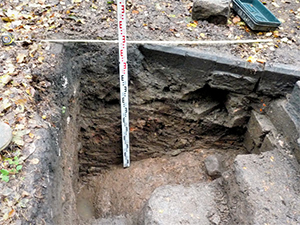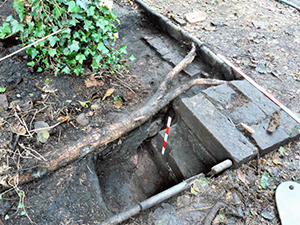
The last time I reported on our activities at the Rectory, we had just discovered the gateposts which marked the entrance to the original late 17th century hall. Since then we have extended our trenches around each of them. The right hand gatepost excavations had revealed what looked like a brick culvert skirting around the post to the right. The bricks forming it are a mixture of old one and not so old ones, possibly early 20th century (one was even 'frogged' i.e. it had a triangular depression on one face). It is also difficult to imagine the structure as a culvert as the soil underneath is so porous it could never have held any water. More likely it was used to protect an electrical cable, which has since been removed.
This trench is now getting quite deep and is showing no sign of the original road structure. In fact, apart from this brick 'culvert', not much else has turned up. The fill is a homogeneous mix of fine loose building rubble and clay with a scattering of pre-Victorian pottery. However, beneath the gatepost itself, which exists to a depth of four courses of stone blocks, there appears to be a hard cobbled surface, significantly though, there is a gap of about 5cm between them. The cobbled surface seems to be on top of a clay bank which drops away towards the hall (we haven't found the bottom of it as it continues under the end of our trench).
 
 The left hand gatepost goes down four courses (similar to the right hand post) and widens in a similar manner at the bottom to form a stable base. However the soil on this side is much different as it consists of compacted earth and clay. The feeling is that the ground in this area has not been disturbed since the posts were erected.
The left hand gatepost goes down four courses (similar to the right hand post) and widens in a similar manner at the bottom to form a stable base. However the soil on this side is much different as it consists of compacted earth and clay. The feeling is that the ground in this area has not been disturbed since the posts were erected.
Running adjacent to the tarmac path (and tucked under its curbing tiles) is a short row of bricks - probably the foundation of a wall which edged the original entrance road up to the hall. (difficult to investigate the road itself here as it lies underneath the tarmac). At the base of the left hand gatepost is another hard surface. It seems similar to the one found one under the right hand post, however, here the surface is about 10cm higher and has been cut into to allow for the lower blocks of the gatepost. This suggests a linear feature running across the original entrance to the hall but pre-dating it. More excavation is need to determine its form and age and whether it is connected to the previous structure (such as manor house).
Next Meeting
Wednesday 4th December - in the Standish Suite at the Brocket Arms (7.30pm as usual). This month we have Richard Sivill, a local historian, who will be telling us about the history the Kirkless Hall Coal & Cannel Co. In the mid 19th century this company developed into the Wigan Coal & Iron Co. becoming one of the largest iron & steel works in Europe. His talk will be really helpful for us as we continue our investigations of this site. In October I reported on our progress with this project (see Newsletter 167). Since then we have made another attempted at surveying the site. However sighting our targets proved difficult due to the tree cover. Hopefully, when the vegetation dies down, we will be able to return to continue our survey. I'm sure Richard's talk will be very interesting. Hope to see you there, BA
|



